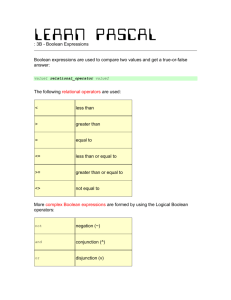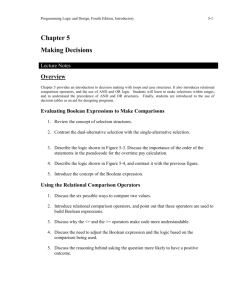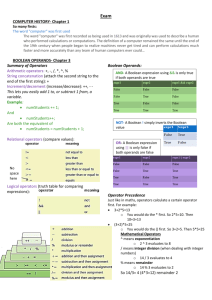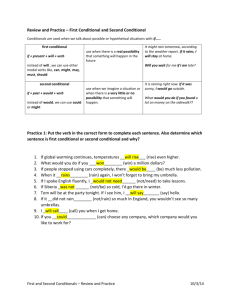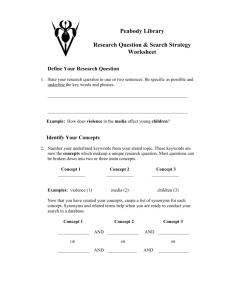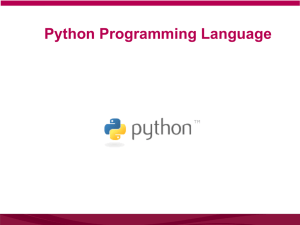n341ControlStructures
advertisement
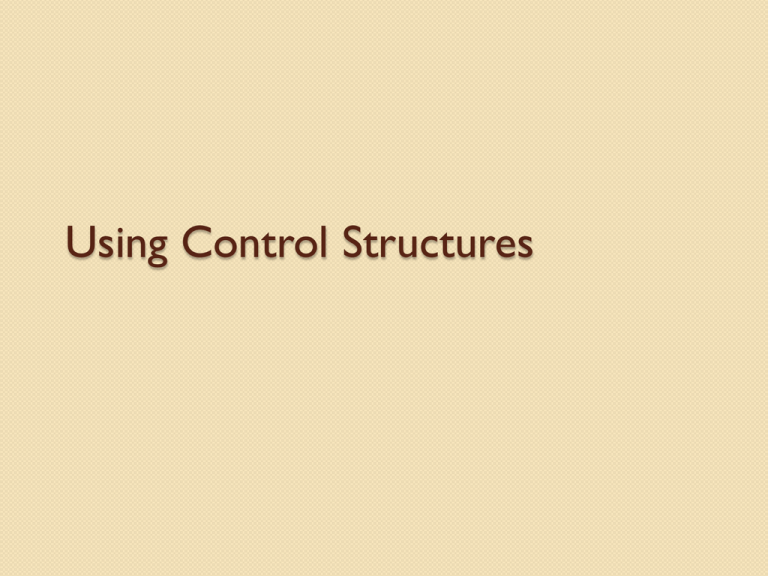
Using Control Structures
Goals
Understand the three basic forms of control structures
Understand how to create and manage conditionals
Understand how to change program execution flow
based on conditionals
Bring it! (Practice with conditionals)
Programming and Control
Structures
All programming languages support Control
Structures
Essentially, control structures give programmers a
toolset for “controlling” what code gets executed,
and how many times.
There are three basic control structures:
◦ Sequential
◦ Branching
◦ Looping
Control Structures: Sequential
Sequential Code – Unless otherwise
indicated, programming instructions are
executed in order… the first line of code,
then the next, then the third.
Sequential processing is the default
control structure (ie, as a programmer,
you get it without asking!)
Control Structures: Branching
Branching structures allow the
programmer to structure mutually
exclusive blocks of code
Based on the value of some conditional,
either one block of code executes or
another….
For example: If it’s raining, take an
umbrella. Else, leave the umbrella at home.
Control Structures: Looping
Looping structures allow the programmer
to create repeating blocks of code.
The code can repeat zero or many times,
based on the value of some conditional.
For example: Would you like to play a
game? Game is played and ends, and the
user is asked: Would you like to play
again? Game is played and ends, and the
user is asked: Would you like to play
again…
Understanding Conditionals
In a later presentation, we will look at
branching and looping in detail, but for now,
let’s flesh out the toolset of the conditional
A conditional is a Boolean expresssion that
can be used to control program execution.
(And btw, a Boolean expression is one that
can be evaluated as True or False)
As it turns out, you already know quite a bit
about conditionals!
“Concepts” to “Conditions”
Consider the following statements:
◦ “It’s raining.”
◦ “Your shirt is blue.”
◦ “There are no more records in the file.”
◦ “The user clicked ‘YES’”
All of these statements are Boolean expressions – we could figure out if each is
a True or False statement
On the other hand, an expression such as “x + 3” isn’t a Boolean. Even if you
told me what x was, ‘x + 3’ doesn’t result in a True or False.
Programmers construct conditionals to act as Guards in front of a section of
code… if the conditional is TRUE, the guard let’s you pass into a section of code.
If the conditional is FALSE, the guard blocks you from entering.
The Conditional as Sentry
So… consider the following conditional:
If (x > 3)
{Do a bunch of fun stuff;
Including more fun stuff;
and even more fun stuff;
and yati, yati, yati!!!}
Else
{Poke yourself in the eye with a sharp
stick}
The conditional (x>3) stands guard in front of the fun lines of code. If the expression turns out to
be True (ie, x IS greater than 3), the sentry (ie, soldier) lets you pass into the fun code. This
sentry analogy is so compelling that the variable in a conditional is referred to as the
“sentinel” value.
If the conditional is False, the sentinel blocks you from entering the fun code and yikes, you gotta
get that stick….
Given how important the conditional is, it’s worth understanding in
detail the power it offers a programmer.
Using the Relational Operator
The relational (comparison) operator compares
two values of THE SAME TYPE (i.e. – Strings are
compared to strings, integers are compared to
integers, etc.)
There are several different types of comparison
operators (see next slide)
Comparison operators HAVE NO
PRECEDENCE among themselves and are
evaluated LEFT to RIGHT (however,
parentheses can be added to alter precedence)
Available Relational Operators
Comparison
Is equal to
Is not equal to
Is less than
Is less than or equal to
Is greater than
Is greater than or equal to
JavaScript Relational Operator
==
!=
<
<=
>
>=
Multiple Conditions
Sometimes, it’s necessary to combine
multiple conditions to form a single, more
complex text.
It is a good idea to first establish a table (on
paper) mapping the multiple conditions, the
possible responses and the program’s
reaction to responses.
Boolean Operators
Sometimes, conditions can be joined together in
the same test using Boolean operators:
◦ Logical AND is represented by &&
Example: if (A = B && C = D) …
◦ Logical OR is represented by ||
Example: if(A = B || C = D) …
◦ Logical NOT is represented by ! (bang symbol)
Example: if( !(A = B) ) …
Boolean Precedence: NOT, followed by AND,
followed by OR
More on Boolean Operators
From Boolean expressions, we can develop
Truth Tables:
Cond A
Cond. B
A && B
A || B
!(A)
T
T
F
F
T
F
T
F
T
F
F
F
T
T
T
F
F
F
T
T
Multiple Conditions
Cond.
Question
Yes No
Response
I
Weekend?
First day?
X
X
-
II
Weekend?
First day?
Weekend?
X
-
- Response 3
X Response 4
X Response 5
First day?
Weekend?
First day?
X
-
- Response 6
X Response 7
X Response 8
III
IV
Response 1
Response 2
Operator Precedence
Order
Description
1
Dot Operator
2
Parenthesis (Work from inside
out)
3
Instance Operator
4
Multiplication, Division, Modulus
5
Addition, Subtraction,
Concatenation
Operator
.
()
new
* / %
+ -
Operator Precedence (continued)
Order
Description
Operator
6
Assignment
= += -=
*= /= %=
7
Comparison Operators
<, >, <=, >=
8
Inequality
9
Boolean AND
&&
Boolean OR
||
10
!=
Boolean Values
When testing against Boolean values, you can
use shortcuts (True Example):
if(myVar == true) …
is the same thing as
if(myVar) …
False Example:
if(myVar == false) …
is the same thing as
if(!(myVar)) …
window.confirm() Method
Boolean values are returned by the
window.confirm() method.
window.confirm() takes input from the
user, based on which button they choose
(OK=TRUE & CANCEL=FALSE)
It looks and feels a lot like window.alert(),
except that it has both an OK and a
CANCEL button
window.confirm() &
Boolean Example
Code Example
Questions?
Resources
JavaScript: The Definitive Guide by David Flanagan
(O’Reilly, 2002)
JavaScript Concepts & Techniques: Programming
Interactive Web Sites by Tina Spain McDuffie
(Franklin, Beedle & Associates, 2003)
Extended Prelude to Programming: Concepts and
Design by Stewart Venit (Scott/Jones, Inc., 2002)
